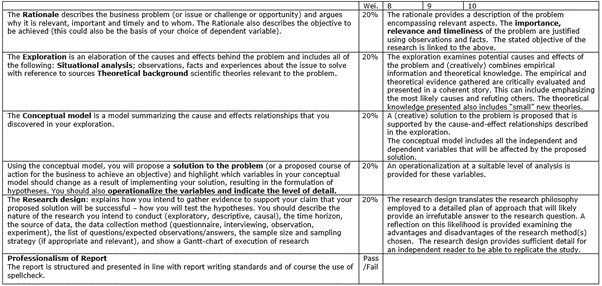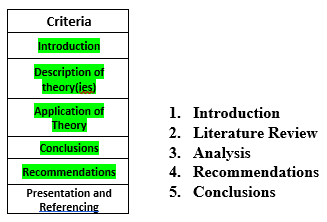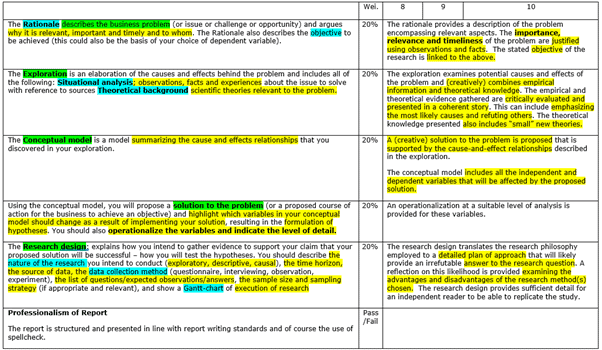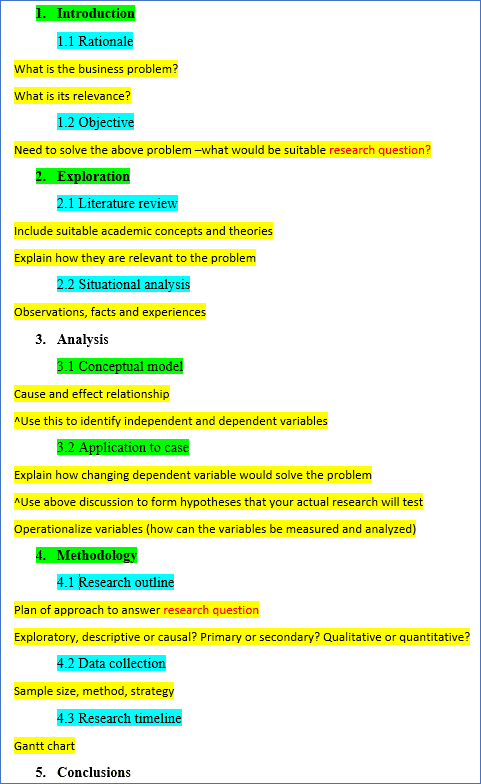As we’ve covered in detail in a separate guide, GPA is important for university admissions and job applications. There’s no shortage of resources on the internet listing different things you can do to get better grades. However, there’s one relatively easy method to improve grades which we’re surprised to see many students not making proper use of.
To ensure that you get better grades, you should be structuring your paper around the marking criteria, guidelines, or rubrics, which are provided by the teachers or professors. Although they are tools of assessment for the teachers, from the perspective of students, these are tools of communication which help inform them about what is being expected of them so that they can align their papers with the requirements.
So, here’s a step-by-step guide on how you can ‘hack’ your assignment rubric and use it as a roadmap to prepare the general outline for your paper to help you get better grades. This is especially important for those troublesome assignments where the actual assignment requirements files do not mention any required or even recommended structure for the assignment.
Table of Contents
General overview of how to use marking criteria to get better grades
By paying attention to the content within the assignment rubric or essay requirements files, you should be able to get better grades – all you need to do make sure that you incorporate some specific wordings which are present in the assignment rubric file and use that to structure your paper into specific subheadings. Going a step further, you should also be looking at the grading structure and identifying the important points which need to be included in your paper as a bare minimum.
For this guide, we will be showing you how to hack the following example rubric, which is for a business research assignment.

Step 1: Make a general outline and structure for your paper
The first step is to go through the first part of the rubric (which is typically the first column from left to right) that goes over the main criteria of assessment. In generic rubrics, this may include a breakdown of the criteria such as content, justification, conclusions, references, and presentations. In more detailed rubrics designed by well-meaning and helpful teachers, the breakdown is often more specific with the inclusion of criteria such as literature review, research design, findings and so on.
The point here is to use whichever of these assessment criteria that you can as headings or subheadings in your paper. We’ve included an example of this below for both types of scenarios – one in which the rubric was broad, and another in which the rubric was quite detailed.

As you can see from the above images, all we need to do is to just take the keywords and convert them into main headings for our paper. This will give you a basic outline and structure that you can flesh out further by following the next steps. The purpose of this twofold – this would be a much easier approach than racking your brain trying to come up with an outline from scratch, but more importantly, when you approach the assignment structure in this way, you are giving your teacher the exact outline that they are expecting to see when they are grading your paper.
You may have noticed that some keywords from the rubric were changed to something else in our draft structure. If you were not able to understand the reason why we’ve done this, we suggest reading our articles on basic assignment structure, along with our guide on some common words used in academic writing and what they actually mean.
You should read these guides to supplement your understanding of the words that you may find in a rubric and how they should be tweaked as part of your assignment paper structure and headings.
At times, you may get a rubric which is broad and generic and doesn’t list out the grading criteria in detail. If so, then you don’t need to feel discouraged – if you follow the guides mentioned above and this one, you should still be able to find suitable headings, subheadings, and key concepts. We show this with the following example. As you can see, we have converted some of the broader grading criteria into standard academic paper headings.

Step 2: Refine your headings and subheadings further
Once you have a general outline prepared, the next step is to refine it further and find suitable subheadings to streamline and organize your content into.
If you have a detailed rubric from your teacher, you should be able to find some other words that can be made into subheadings, as we illustrate with blue highlights in the next image and the right-side of the image should show you how these wordings were adapted to suit our original draft assignment structure from the previous step.

Step 3: Find ‘pointer’ keywords on additional information the grader is expecting
Once you have completed the first two steps, you should already have a fairly good idea of what your paper is going to look like. After that, you should move on to analyzing the other parts of the rubric to identify some further important words, concepts or specific grading points that the teacher is looking for within the broader grading criteria.
What you need to realize is that the teachers have included these words for the sole purpose of pointing you towards the answers and what they’re expecting. So, it stands to reason that giving them what they want should help you secure better grades. We show this using the same example rubric in the following image.

We went into the rubric once again and dissected every part of it to identify additional words that seem to give us an idea of what the teacher wants. The parts highlighted in yellow were what we can discover by scrutinizing further. We then made a note of the key points within our assignment outline, which we have now converted into the initial rough draft of our assignment and shall be using as the working file to build further on.
Ultimately, this is what our outline file looks like and once you get to this point, it should be much easier for you to find suitable content relevant to this outline and complete your paper.

Although it should be fairly obvious, it is worth mentioning that you should not be limiting yourself only to the rubric. For this particular step, you should also be relying on the actual assignment requirements files to make sure that you cover other essential points required in your assignment.
Step 4: Use the grading weights to balance word count
Sometimes, the assignment rubrics would also include ‘weights’ that will be used by the teacher for grading. In our example rubric, the weight was mentioned as 20% for each of the five main grading criteria. Let’s assume that the word count for this paper was 3,000 words.
If you have already gone through our guide on how to make introductions and conclusions for your paper, you should have realized that we would have about 200 to 300 words for each of these, which leaves about 2,500 words for the rest of your paper. If we split this remaining allowance of 2,500 words across the 5 sections which we have identified, it means that we need to write about 500 words in each section.
The benefit of this step is that you do not need to worry about how much you need to write for each section. Additionally, as we’re sure you would agree, there’s no good reason why you should spend a lot of time on a section which is weighted very low, so having this clarity on how many words need to go in each section should also help you manage your time better and adapt your research and writing process accordingly.
Step 5: Review your paper one last time against the rubric and assignment requirements
Once you have completed your assignment in line with the draft outline that you prepared up to step 4, you should come back to the rubric once again at the very end to see if the final result reflects the marking criteria, grading rubric or assignment requirement files.
When you’re doing your research, it is very easy to get sidetracked and add a lot of content that may not be required, either unconsciously, or as ‘padding’ to meet the word count. Hence, it is very important you go back and self-assess your assignment against the rubric to see if you may have overlooked anything.
And that’s it – if you’ve followed these steps, you should be giving yourself a better chance of getting better grades but having a solid outline can only get you so far because actual research and execution is where you make or break it. We have some a lot of other guides on our website to help with the actual research and execution phases, so please be sure to check them out to get a more comprehensive understanding.

